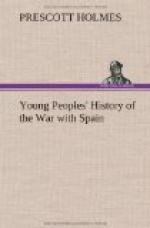General Lawton, you will remember, was the famous officer who fought so gallantly in Cuba, particularly at the battle of El Caney, and was after wards sent to the Philippines. Upon his arrival in the islands he was at once given a command, and began to hunt down, the Filipinos. He fought as bravely and gallantly in the Philippines as he did in Cuba, capturing many rebel strongholds and considerable quantities of arms and ammunitions. He took a large number of prisoners and kept up such a tireless pursuit of the insurgents that they fled before him in terror. In fighting the Filipinos he used the same tactics that he had employed against the Indians in this country. He allowed his troops to fight in Indian fashion, each man for himself, when occasion required; and he had the love and respect of every man in his command.
General Lawton was specially thanked by President McKinley after his capture of San Isidro, where he led his men in person, as he almost invariably did. He was one of the bravest of men, and met a soldier’s death in a skirmish at San Mateo, on December 18th, 1809.
When the news of General Lawton’s death reached this country, the people quickly raised a fund, amounting to about one hundred thousand dollars, for his wife and children, as a token of their appreciation of his distinguished services. His remains were brought to the United States on a Government transport, and after lying in state at Fort Wayne and Indianapolis, Indiana, were laid to rest in Arlington Cemetery, near the city of Washington, D.C.
You will remember that our war with Spain began on April 21st, 1808, and that it ended with the signing of the peace protocol, on August 12th of the same year; but I hardly think you know what these one hundred and fourteen days cost this country.
The cost in men was two thousand, nine hundred and ten, and of these one hundred and seven were officers. The total force engaged was two hundred and seventy-four thousand, seven hundred and seventeen officers and men.
The cost in money was about $1,250,000 for each day of the war, and if you reckon that up you will find that it amounts to an enormous sum of money.
The only American vessel that was lost was the collier Merrimac, which was sunk in Santiago harbor by our own navy.
Spain’s losses will probably never be given out, for national pride will not permit her to publish the figures. We know, however, that she lost twelve cruisers, two torpedo-boat destroyers and twenty-one gunboats from her list of fighting ships. The value of Admiral Cervera’s squadron, which was destroyed at Santiago, alone was $20,000,000. Besides capturing or destroying these war vessels, we took from Spain, during the war, twenty-four steam vessels, sixty-one sailing vessels and sixty-one lighters.
It is impossible to give Spain’s losses in men, killed and wounded, but she surrendered to us in Cuba and the Philippines something more than thirty-nine thousand men. According to the terms of the capitulation at Santiago, this country sent nearly twenty-three thousand prisoners home to Spain.




